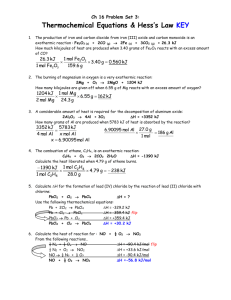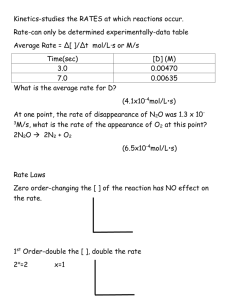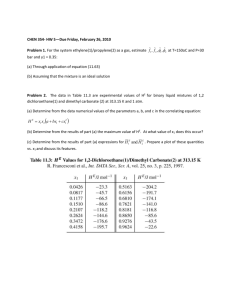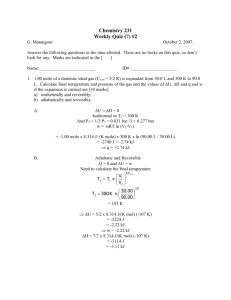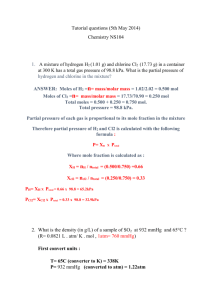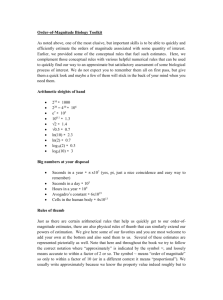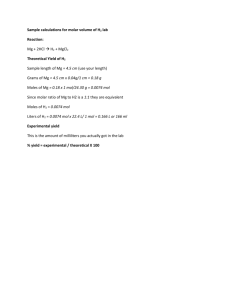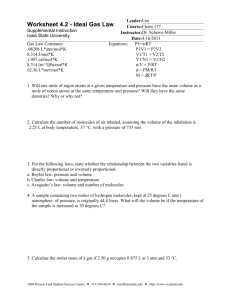Problem Set: Heat, Hess`s Law and Heats of Formation
advertisement
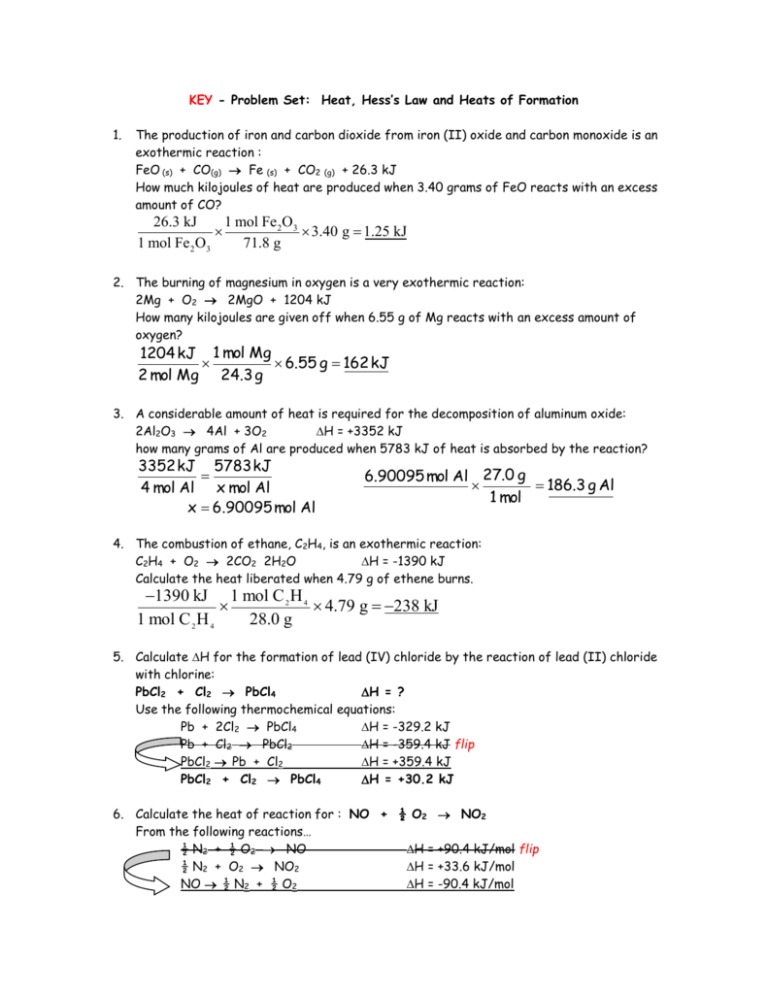
KEY - Problem Set: Heat, Hess’s Law and Heats of Formation 1. The production of iron and carbon dioxide from iron (II) oxide and carbon monoxide is an exothermic reaction : FeO (s) + CO(g) Fe (s) + CO2 (g) + 26.3 kJ How much kilojoules of heat are produced when 3.40 grams of FeO reacts with an excess amount of CO? 1 mol Fe 2O3 26.3 kJ 3.40 g 1.25 kJ 1 mol Fe 2O3 71.8 g 2. The burning of magnesium in oxygen is a very exothermic reaction: 2Mg + O2 2MgO + 1204 kJ How many kilojoules are given off when 6.55 g of Mg reacts with an excess amount of oxygen? 1204 kJ 1 mol Mg 6.55 g 162 kJ 2 mol Mg 24.3 g 3. A considerable amount of heat is required for the decomposition of aluminum oxide: 2Al2O3 4Al + 3O2 H = +3352 kJ how many grams of Al are produced when 5783 kJ of heat is absorbed by the reaction? 3352 kJ 5783 kJ 4 mol Al x mol Al x 6.90095 mol Al 6.90095 mol Al 27.0 g 186.3 g Al 1 mol 4. The combustion of ethane, C2H4, is an exothermic reaction: C2H4 + O2 2CO2 2H2O H = -1390 kJ Calculate the heat liberated when 4.79 g of ethene burns. 1390 kJ 1 mol C 2 H 4 4.79 g 238 kJ 1 mol C 2 H 4 28.0 g 5. Calculate H for the formation of lead (IV) chloride by the reaction of lead (II) chloride with chlorine: PbCl2 + Cl2 PbCl4 H = ? Use the following thermochemical equations: Pb + 2Cl2 PbCl4 H = -329.2 kJ Pb + Cl2 PbCl2 H = -359.4 kJ flip PbCl2 Pb + Cl2 H = +359.4 kJ PbCl2 + Cl2 PbCl4 H = +30.2 kJ 6. Calculate the heat of reaction for : NO + ½ O2 NO2 From the following reactions… ½ N2 + ½ O2 NO H = +90.4 kJ/mol flip ½ N2 + O2 NO2 H = +33.6 kJ/mol NO ½ N2 + ½ O2 H = -90.4 kJ/mol NO + ½ O2 NO2 H =-56.8 kJ/mol 7. Calculate the heat change for the formation of copper (I) oxide from the elements: Cu + ½ O2 CuO Use the following two thermochemical equations to make the calculations: CuO + Cu Cu2O H = -11.3 kJ Cu2O + ½ O2 2CuO H = -114.6 kJ add as is Cu + ½ O2 CuO H =-125.9 kJ 8. Find the enthalpy change (H) for the formation of phosphorus pentachloride from its elements. 2P + 5Cl2 2PCl5 Use the following equations: PCl5 PCl3 + Cl2 H = +87.9 kJ x 2 and flip 2P + 3 Cl2 2PCl3 H = -574 KJ 2PCl3 + 2Cl2 2PCl5 H = -175.8 kJ 2P + 5Cl2 2PCl5 H =-750. kJ 9. Calculate the heat change, H, for the formation of nitrogen monoxide from its elements: N2 + O2 2NO Use these equations: 4NH3 + 3O2 2N2 + 6H2O H = -1530 kJ flip 4NH3 + 5O2 4NO + 6H2O H = -1170 kJ 2N2 + 6H2O 4NH3 + 3O2 H = +1530 kJ 2N2 + 2O2 4NO H = +360 kJ divide by 2 N2 + O2 2NO H =+180 kJ 10. Calculate the heat change, H, for the formation of nitrogen monoxide from its elements: H2S(g) + 4F2(g) 2HF + SF6(g) Use these equations: ½ H2(g) + ½ F2 (g) HF(g) H = -273 kJ multiply by 2 S(s) + 3F2 (g) SF6(g) H = -1220 kJ H2 (g) + S(s) H2S(g) H = -21 kJ flip H2S(g) H2 (g) + S(s) H = +21 kJ H2(g) + F2 (g) 2HF(g) H = -546 kJ H2S(g) + 4F2(g) 2HF + SF6(g) H =-1745 kJ
